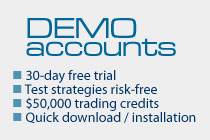 |
|||
 | |||
|
We offer FX, FX Options, Contracts for Difference and Precious Metal trading delivered on the most powerful trading platform technologies.\ | Contract For Difference (CFD) CFD (Contract for Difference) is a tool that allows you to “derive” equity profit (hence the term “derivatives”) from changes in the price of an underlying asset, no matter whether the price rises or falls, without the need for ownership of the underlying shares. CFD’s offers the benefits of trading financial instruments such as Equities, Commodities or Treasuries without having to physically own the underlying instrument itself which may be shares, bonds, futures, currencies, commodities, etc. A CFD is a kind of “clone” of the underlying asset allowing investors to take long or short positions, and unlike futures contracts have no fixed expiry date or contract size. It is an agreement between two parties to exchange the difference between the sell and buy price of a contract, multiplied by the quantity of units of the underlying asset as stipulated in the contract. This instrument is a product of the Over-the-Counter (OTC) market. This instrument appeals to customers with a relatively low deposit who would like to trade in capital intensive markets. The official definition is that a Contract for Difference (CFD) is an agreement between two parties to exchange the difference between the opening price and the closing price of the contract, at the close of the contract, multiplied by the number of units of the underlying commodity specified within the contract. (If the difference is negative, then the buyer pays instead to the seller.) Trades are conducted on a leveraged basis with margins typically ranging from 1% to 30% of the notional value for CFDs on leading equities. CFDs are currently available in listed and/or over-the-counter markets in the United Kingdom, Germany, Switzerland, Italy, Singapore, South Africa, Australia, Canada, New Zealand and most recently Sweden. CFDs are no longer permitted in the United States, due to restrictions by the U.S. Securities and Exchange Commission on OTC financial instruments. Remember, CFDs are a leveraged product and can result in losses that exceed your initial deposit. CFDs may not be suitable for everyone, so please ensure that you fully understand the risks involved. The most important advantages of CFDs are: Low level of the initial deposit Low commission rates Elimination of the underlying commodities physical delivery risks Leverage Immediate dealing One of the most attractive aspects of trading CFDs is the easily available access to leverage. Leverage involves taking a small deposit and using it as a lever to borrow and gain access to a larger equivalent quantity of assets. CFDs use the power of leverage to trade which is one of the key reason they are such a powerful tool. CFDs are collateral financed, meaning you only need an initial margin of 1-30% of the total value of the trade to enter the position. For Example: If you wish to enter a position of 1000 BHP Shares at $35 each, usually you would need to front $35,000. Using CFDs, trading on a 5% margin, you would only need an initial deposit of $1,750. An example is the easiest way to show the power of leverage. If you had $1,750 to invest, and wished to purchase BHP at $35 and sell at $37, a standard trade would look as follows: BUY: 50 x $35 = $1,750 Using the power of leverage the above example reads as follows: BUY: 1,000 x $35 = $1,750 (5% deposit) + $33,250 As you can see the profit received after using leverage was far greater than without. It is important to note, that losses are also magnified when using leverage. Furthermore, Commodity markets are very volatile and give an excellent opportunity for CFD traders to make profit out of commodity price movements. |
||


